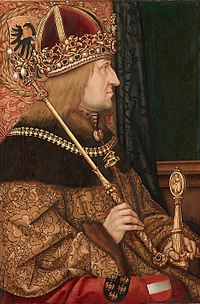Frederick III, Holy Roman Emperor

Frederick or Friedrich of Habsburg (September 21 1415 – August 19, 1493) was Duke of Austria as Frederick V since 1424, successor of Albert II as German King as Frederick IV since 1440, and Holy Roman Emperor as Frederick III since 1452. He was succeeded by Maximilian I in 1493 after ten years of joint rule.
Life
Born in Innsbruck, he was the son of Duke Ernest the Iron from the Leopoldinian line of the Habsburg family ruling Inner Austria, i.e. Styria, Carinthia, and Carniola, and of Ernest's wife Cymburgis of Masovia. As an Austrian Habsburg Duke, he became Frederick V in 1424. In 1440 he was elected German king as Frederick IV, and in 1452 crowned Holy Roman Emperor as Frederick III. He married in 1452, at age 37, the 18-year-old Princess Eleonor of Portugal, whose dowry helped him to alleviate his debts and cement his power.
In 1442, Frederick allied himself with Rudolf Stüssi, burgomaster of Zürich, against the Old Swiss Confederacy in the Old Zürich War (Alter Zürichkrieg).
In 1448, he entered into the Vienna Concordat with the Holy See, which remained in force until 1806 and regulated the relationship between the Habsburgs and the Holy See.
Frederick was the last Emperor to be crowned in Rome, being crowned in 1452 by Pope Nicholas V. He opposed the reform of the Holy Roman Empire at that time and was barely able to prevent the electors from electing another king.
Politics

His politics were hardly spectacular but still successful. His first major opponent was his brother Albert VI, who challenged his rule. He did not manage to win a single conflict on the battlefield, and thus resorted to more subtle plans. He held his nephew Ladislaus Posthumus, the ruler of the Archduchy of Austria, Hungary and Bohemia, (born in 1440) as a prisoner and attempted to extend his guardianship over him in perpetuity to maintain his control over Lower Austria. Ladislaus was freed in 1452 by the Lower Austrian estates. He acted similarly towards his nephew Sigismund of the Tyrolian line of the Habsburg family. Despite those efforts, he failed to gain control over Hungary and Bohemia, and was even defeated by the Hungarian King Matthias Corvinus in 1485, who managed to reside in Vienna until his death five years later. Ultimately, Frederick prevailed in all those conflicts by outliving his opponents and sometimes inheriting their lands, as was the case with his nephew Ladislaus Posthumus, from whom he gained Lower Austria in 1457, and with his brother Albert VI, whom he succeeded in Upper Austria. These conflicts forced him to an anachronistic itinerant existence, as he had to move his court between various places through the years, residing in Graz, Linz and Wiener Neustadt. Wiener Neustadt owes him its castle and the "New Monastery".
Still, in some ways his policies were astonishingly successful. In the Siege of Neuss (1474-75), he could force Charles the Bold of Burgundy to give his daughter Mary of Burgundy as wife to Frederick's son Maximilian. With the inheritance of Burgundy, the House of Habsburg began to rise to predominance in Europe. This gave rise to the saying "Let others wage wars, but you, happy Austria, shall marry", which became a motto of the dynasty.
The marriage of his daughter Kunigunde of Austria to Albert IV, Duke of Bavaria, was another result of intrigues and deception, but must be counted as a defeat for Frederick. Albert illegally took control of some imperial fiefs and then asked to marry Kunigunde (who lived in Innsbruck, far from her father), offering to give her the fiefs as a dowry. Frederick agreed at first, but after Albert took over yet another fief, Regensburg, Frederick withdrew his consent. On January 2, 1487, however, before Frederick's change of heart could be communicated to his daughter, Kunigunde married Albert. A war was prevented only by intermediation by the Emperor's son, Maximilian.
In some smaller matters, Frederick was quite successful: in 1469 he managed to establish bishoprics in Vienna and Wiener Neustadt, a step that no previous Duke of Austria had been able to achieve.
Death
At the age of 77, Frederick III died at Linz in a failed attempt to have his left leg amputated. His grave, built by Nikolaus Gerhaert von Leyden, in the Stephansdom in Vienna, is one of the most important works of sculptural art of the late Middle Ages. His amputed leg was buried with him.
For the last ten years of Frederick's life, he and Maximilian ruled jointly.
Coat of Arms
| Holy Roman Emperor |
|---|

|
| Coats of arms |
Ancestors
| Family of Frederick III, Holy Roman Emperor | ||||||||||||||||||||||||||||||||||||||||||||||||||||||||||||||||||||||||||||||||||||||||||||||||||||||||||||||||||||||||||||||||||||||||||||||||||||||||||||||||||||||||||||||||||||||||||||||||||||||||||||||||||||||||||||||||||||||||||||||||||||||||||||||||||||||||||||||||||||||||||||||||||||||||||||||||||||||||||||||||||||||||||||||||||||||||||||||||||||||||||||||||||||||||||||||||||||||||||||||||||||||||||||||||||||||||||||||||||||||||||||||||||||||||||||||||||||||||||||||||||||||||||||||||||||||||||||||||||||||||||||||||||||||||||||||||||||||||||||||||||||||||||||||||||||||||||||||||
|---|---|---|---|---|---|---|---|---|---|---|---|---|---|---|---|---|---|---|---|---|---|---|---|---|---|---|---|---|---|---|---|---|---|---|---|---|---|---|---|---|---|---|---|---|---|---|---|---|---|---|---|---|---|---|---|---|---|---|---|---|---|---|---|---|---|---|---|---|---|---|---|---|---|---|---|---|---|---|---|---|---|---|---|---|---|---|---|---|---|---|---|---|---|---|---|---|---|---|---|---|---|---|---|---|---|---|---|---|---|---|---|---|---|---|---|---|---|---|---|---|---|---|---|---|---|---|---|---|---|---|---|---|---|---|---|---|---|---|---|---|---|---|---|---|---|---|---|---|---|---|---|---|---|---|---|---|---|---|---|---|---|---|---|---|---|---|---|---|---|---|---|---|---|---|---|---|---|---|---|---|---|---|---|---|---|---|---|---|---|---|---|---|---|---|---|---|---|---|---|---|---|---|---|---|---|---|---|---|---|---|---|---|---|---|---|---|---|---|---|---|---|---|---|---|---|---|---|---|---|---|---|---|---|---|---|---|---|---|---|---|---|---|---|---|---|---|---|---|---|---|---|---|---|---|---|---|---|---|---|---|---|---|---|---|---|---|---|---|---|---|---|---|---|---|---|---|---|---|---|---|---|---|---|---|---|---|---|---|---|---|---|---|---|---|---|---|---|---|---|---|---|---|---|---|---|---|---|---|---|---|---|---|---|---|---|---|---|---|---|---|---|---|---|---|---|---|---|---|---|---|---|---|---|---|---|---|---|---|---|---|---|---|---|---|---|---|---|---|---|---|---|---|---|---|---|---|---|---|---|---|---|---|---|---|---|---|---|---|---|---|---|---|---|---|---|---|---|---|---|---|---|---|---|---|---|---|---|---|---|---|---|---|---|---|---|---|---|---|---|---|---|---|---|---|---|---|---|---|---|---|---|---|---|---|---|---|---|---|---|---|---|---|---|---|---|---|---|---|---|---|---|---|---|---|---|---|---|---|---|---|---|---|---|---|---|---|---|---|---|---|---|---|---|---|---|---|---|---|---|---|---|---|---|---|---|---|---|---|---|---|---|---|---|---|---|---|---|---|---|---|---|---|---|---|---|---|---|---|---|---|---|---|---|---|---|---|---|---|---|---|---|---|---|---|---|---|---|---|---|---|---|---|---|---|---|---|---|---|---|---|---|---|---|---|---|---|---|---|---|---|---|---|---|---|---|---|---|---|---|---|---|---|---|---|---|---|---|---|---|---|---|---|---|---|---|---|---|---|---|---|---|---|---|---|---|---|---|---|---|---|---|---|---|---|---|---|---|---|---|---|---|---|---|---|---|---|---|---|---|---|---|---|
| ||||||||||||||||||||||||||||||||||||||||||||||||||||||||||||||||||||||||||||||||||||||||||||||||||||||||||||||||||||||||||||||||||||||||||||||||||||||||||||||||||||||||||||||||||||||||||||||||||||||||||||||||||||||||||||||||||||||||||||||||||||||||||||||||||||||||||||||||||||||||||||||||||||||||||||||||||||||||||||||||||||||||||||||||||||||||||||||||||||||||||||||||||||||||||||||||||||||||||||||||||||||||||||||||||||||||||||||||||||||||||||||||||||||||||||||||||||||||||||||||||||||||||||||||||||||||||||||||||||||||||||||||||||||||||||||||||||||||||||||||||||||||||||||||||||||||||||||||
See also
- Kings of Germany family tree. He was related to every other king of Germany.
References
- Heinig, Paul-Joachim. "The Court of Emperor Frederick III". In Princes Patronage and the Nobility: The Court at the Beginning of the Modern Age, cc. 1450-1650. Edited by Ronald G. Asch and Adolf M. Birke. New York: Oxford University Press, 1991. ISBN 0199205027.
- Roman Catholic monarchs
- Holy Roman Emperors
- House of Habsburg
- German kings
- Dukes of Austria
- Dukes of Styria
- Dukes of Carinthia
- Knights of the Garter
- Knights of the Golden Fleece
- Pretenders to the Hungarian throne
- Medieval child rulers
- Recipients of the Golden Rose
- People from Innsbruck
- 1415 births
- 1493 deaths
- Articles lacking sources (Erik9bot)
